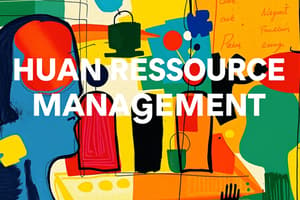Podcast
Questions and Answers
What is a primary focus of Human Resource Management?
What is a primary focus of Human Resource Management?
- Employee Recruitment and Selection (correct)
- Financial Risk Assessment
- Production Planning
- Forecasting Market Trends
Which component is essential for identifying an organization's competitive position?
Which component is essential for identifying an organization's competitive position?
- SWOT Analysis (correct)
- PESTEL Analysis
- Vision Statement
- Balanced Scorecard
Which project management methodology emphasizes adaptability and iterative progress?
Which project management methodology emphasizes adaptability and iterative progress?
- Agile (correct)
- Critical Path Method
- Lean Manufacturing
- Waterfall
What aspect of Operations Management focuses on minimizing waste while ensuring quality?
What aspect of Operations Management focuses on minimizing waste while ensuring quality?
Which financial report provides a summary of income and expenses over a period?
Which financial report provides a summary of income and expenses over a period?
Which tool is commonly used to visualize project timelines and tasks?
Which tool is commonly used to visualize project timelines and tasks?
What key function of financial management focuses on allocating resources to maximize returns?
What key function of financial management focuses on allocating resources to maximize returns?
Which trend in Human Resource Management focuses on creating an inclusive workplace?
Which trend in Human Resource Management focuses on creating an inclusive workplace?
Flashcards are hidden until you start studying
Study Notes
Strategic Management
- Definition: The process of formulating, implementing, and evaluating cross-functional decisions to achieve organizational objectives.
- Key Components:
- Vision and Mission statements
- SWOT Analysis (Strengths, Weaknesses, Opportunities, Threats)
- Competitive Advantage identification
- Long-term Planning
- Tools:
- PESTEL Analysis (Political, Economic, Social, Technological, Environmental, Legal)
- Porter's Five Forces
- Balanced Scorecard
Human Resource Management (HRM)
- Definition: The strategic approach to managing people and the workplace culture and environment.
- Key Functions:
- Recruitment and Selection
- Training and Development
- Performance Management
- Compensation and Benefits
- Employee Relations
- Trends:
- Emphasis on Diversity and Inclusion
- Use of Technology in HR (HRIS, AI Recruitment Tools)
- Employee Engagement Strategies
Project Management
- Definition: The application of knowledge, skills, tools, and techniques to project activities to meet project requirements.
- Key Phases:
- Initiation
- Planning
- Execution
- Monitoring and Controlling
- Closing
- Methodologies:
- Agile
- Waterfall
- Scrum
- Tools:
- Gantt Charts
- Critical Path Method (CPM)
- Project Management Software (e.g., MS Project, Asana)
Operations Management
- Definition: The administration of business practices to create the highest level of efficiency possible within an organization.
- Key Areas:
- Process Design
- Quality Management
- Supply Chain Management
- Inventory Management
- Production Planning
- Techniques:
- Lean Manufacturing
- Six Sigma
- Just-In-Time (JIT) Inventory
Financial Management
- Definition: The management of an organization’s finances to achieve financial objectives.
- Key Functions:
- Financial Planning
- Investment Decisions
- Financing Decisions
- Risk Management
- Reports:
- Income Statement
- Balance Sheet
- Cash Flow Statement
- Key Metrics:
- Return on Investment (ROI)
- Net Present Value (NPV)
- Internal Rate of Return (IRR)
Strategic Management
- Strategic management involves formulating, implementing, and evaluating decisions across various functions to meet organizational goals.
- Vision and mission statements provide direction and purpose for an organization.
- SWOT analysis helps identify internal strengths and weaknesses alongside external opportunities and threats.
- Competitive advantage is essential for differentiating a business in the market.
- Long-term planning focuses on establishing goals and strategies for future growth.
- PESTEL analysis examines external factors: Political, Economic, Social, Technological, Environmental, and Legal.
- Porter's Five Forces model assesses industry competitiveness and market dynamics.
- The Balanced Scorecard provides a framework for measuring organizational performance against strategic goals.
Human Resource Management (HRM)
- HRM is a strategic approach for managing workforce dynamics and workplace culture.
- Recruitment and selection processes are critical for acquiring talent.
- Training and development enhance employee skills and career growth.
- Performance management ensures that employee objectives align with organizational goals.
- Compensation and benefits are vital for attracting and retaining employees.
- Employee relations foster a positive workplace environment.
- Current trends include a strong focus on diversity and inclusion initiatives.
- Technology integration, such as HRIS and AI recruitment tools, is revolutionizing HR practices.
- Employee engagement strategies are essential for maintaining workforce motivation and productivity.
Project Management
- Project management applies knowledge and techniques to fulfill project requirements effectively.
- Key phases include initiation, planning, execution, monitoring and controlling, and closing.
- Agile and Waterfall are prominent project management methodologies with distinct approaches.
- Scrum is a framework used within Agile to manage complex projects in iterative cycles.
- Tools like Gantt charts visually represent project timelines and tasks.
- The Critical Path Method (CPM) identifies essential tasks that affect project duration.
- Software like MS Project and Asana aid in organizing and tracking project progress.
Operations Management
- Operations management optimizes business processes for maximum efficiency within an organization.
- Key areas include process design, focusing on how workflows and systems are structured.
- Quality management ensures that products and services meet consistent standards.
- Supply chain management oversees the flow of goods and services from suppliers to customers.
- Inventory management focuses on maintaining optimal stock levels and minimizing carrying costs.
- Production planning aligns manufacturing processes with market demand.
- Techniques such as Lean Manufacturing aim to eliminate waste while increasing efficiency.
- Six Sigma emphasizes reducing defects and improving quality.
- Just-In-Time (JIT) inventory reduces inventory holding costs by ensuring products arrive as needed.
Financial Management
- Financial management governs an organization’s financial resources to meet financial objectives.
- Key functions encompass financial planning, investment decisions, financing decisions, and risk management.
- Income statements reflect a company's profitability over a specified period.
- Balance sheets provide a snapshot of an organization’s financial position at a given date.
- Cash flow statements track the movement of cash in and out of a business.
- Key financial metrics include Return on Investment (ROI), indicating profitability against investment costs.
- Net Present Value (NPV) evaluates the profitability of a project by comparing present cash flows to initial investment.
- Internal Rate of Return (IRR) estimates the profitability of potential investments over time.
Studying That Suits You
Use AI to generate personalized quizzes and flashcards to suit your learning preferences.




